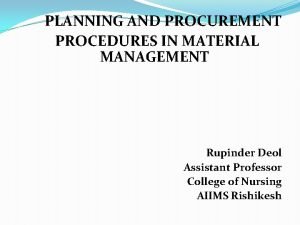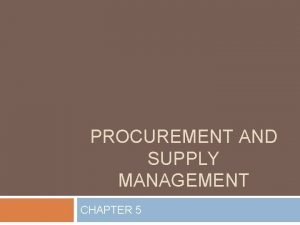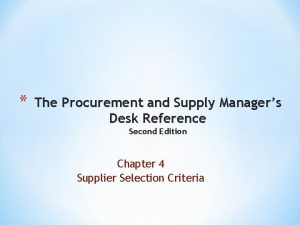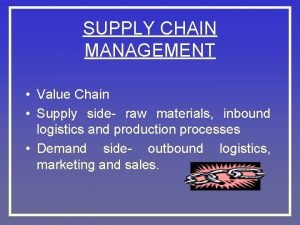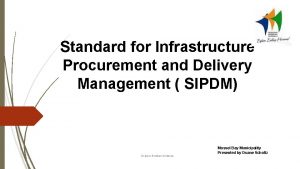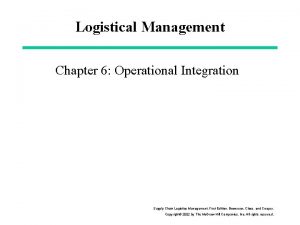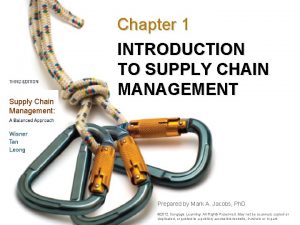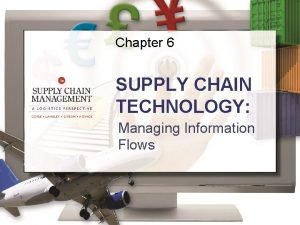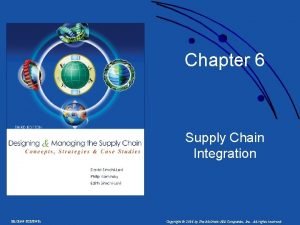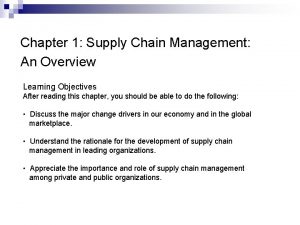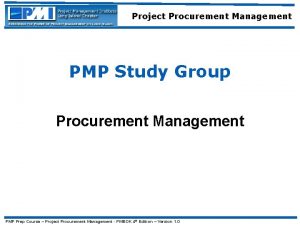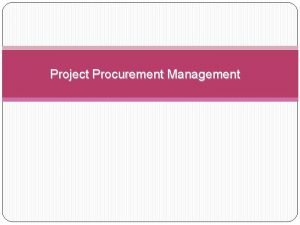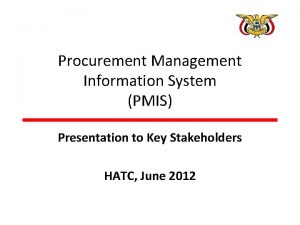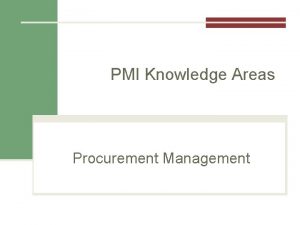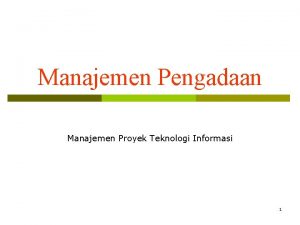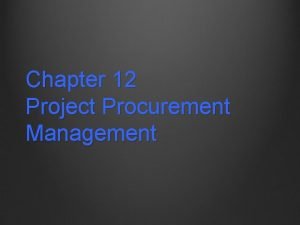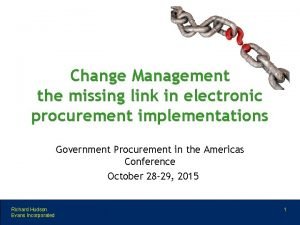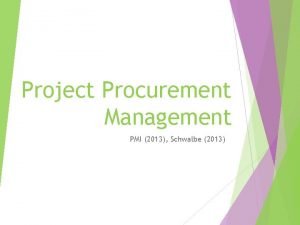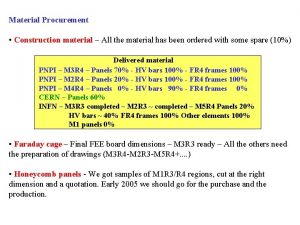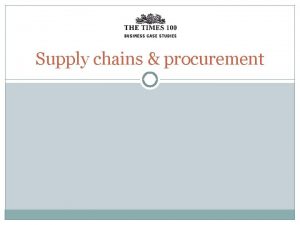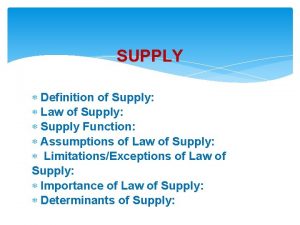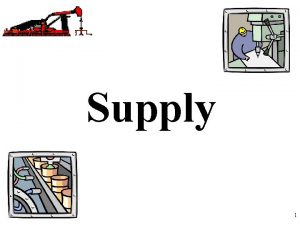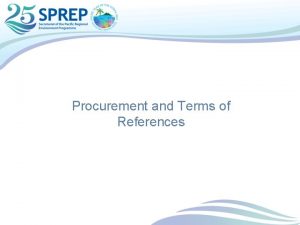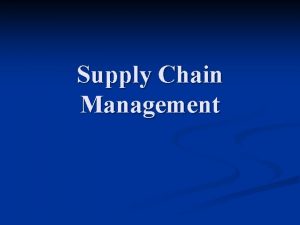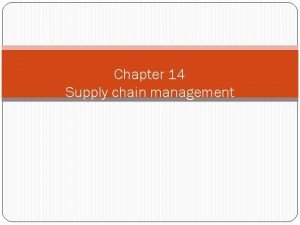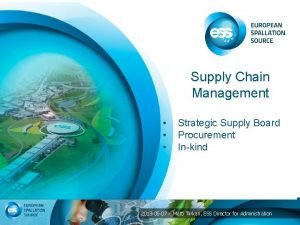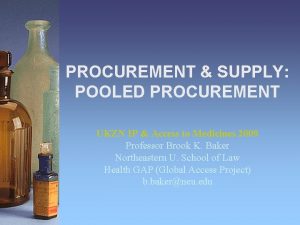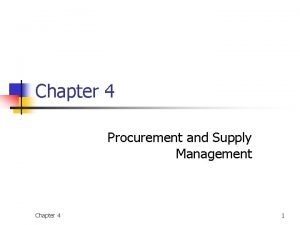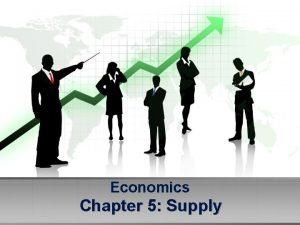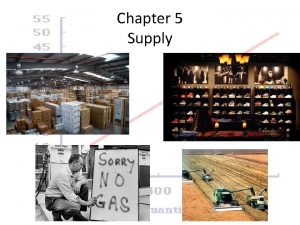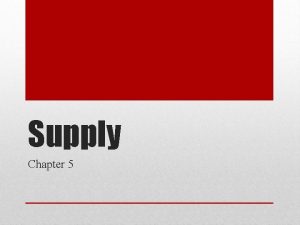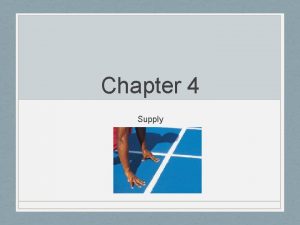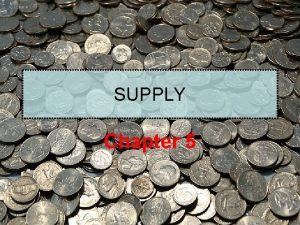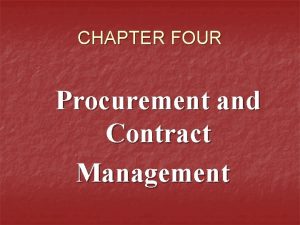PROCUREMENT AND SUPPLY MANAGEMENT CHAPTER 5 MATERIAL MANAGEMENT





























- Slides: 29

PROCUREMENT AND SUPPLY MANAGEMENT CHAPTER 5

MATERIAL MANAGEMENT Materials management is the planning and control of the flow of materials that are part of the inbound logistics system. Materials Management Activities Procurement Importance of Item and Service Purchased The Special Case of Procurement Price Other Materials Management Activities

Materials Management: Procurement Importance Contributes to the competitive advantage of the firm Significant portion of the logistics costs

Definition of Procurement Activities Identify or reevaluate needs Define and evaluate user requirements Decide whether to make or buy Identify the type of purchase Conduct a market analysis Identify all possible suppliers Prescreen all possible source Evaluate the remaining supplier base Choose a supplier Receive delivery of the product or service Make a post purchase performance evaluation

PROCUREMENT PROCESS

Materials Management: Importance of Item and Service Purchased Products and services purchased by a company are not all the same. Some are more important than others and require greater procurement attention. The quadrant technique enables the supply chain manager to assess the relative importance of each item based on the degree of perceived value and risk.

There are four possible combinations in the quadrant techniques model: Generics --- low risk, low value Commodities --- low risk, high value Distinctives --- high risk, low value Criticals --- high risk, high value Figure 4 -3 illustrates the relationships in the quadrant technique model.

Figure 4 -3 Item Procurement Importance Matrix

Materials Management: Managing the Procurement Process in 4 Steps 1. Determine the type of purchase New Straight rebuy Modified rebuy

2. Identify the type of purchase Determine the necessary levels of investment of time and information. The more complex the purchase, the more time needs to be spent and more information needs to be gathered to get it right the first time.

3. Perform the procurement process Do those activities that are necessary to effectively make a purchase and satisfy the user’s requirements. 4. Evaluate the effectiveness of the procurement process Were the user’s needs satisfied? Was the investment necessary?

Materials Management: Managing the Procurement Process Supplier/Vendor Evaluation and Relationships Maintaining a healthy vendor relationship is a critical part of a successful supply chain. Developing a true partnership relationship with a firm’s vendors grows more important as the number of vendors shrinks and/or the vendors are being sought by other competing supply chains. TQM begins with the vendors.

Vendor Selection Criteria Quality Reliability Capability Financial Miscellaneous Other Qualities Vendor Location Factor Importance Will Vary

Overview of Vendor Selection Criteria

Materials Management: The Special Case of Procurement Price Sources of Price Commodity Price markets lists Price quotations Negotiation

Hierarchy of Price Measurement Approaches

Types of Costs Traditional basic input costs – primary product price Direct transaction costs - all other related costs of detecting and transmitting information to suppliers (e. g. , EDI) Supply relational costs - costs of maintaining relationships with suppliers

Total Procurement Price

Other types of Costs Landed costs - actual transport costs + sales terms Quality costs/factors - do the goods conform to standard?

Overview of Production Planning and Control

Other types of Costs Operations/logistics costs Receiving and make-ready costs Lot size costs Production costs Other logistics costs affected by product’s size, weight, density and shape

Materials Management: Other Materials Management Activities Warehousing Type of required facilities Production Planning and Control Coordinatingproduct supply with product demand Transportation Vendor control Modal choice Rush shipments Inspection Damage claims

Quality Control Quality did standards customer receive what was ordered? Quality GIGO implications concept Sample inspection statistical QC from vendor to assure 100% quality

Salvage and Scrap Disposal Value of scrap may be income to the firm. Disposal must adhere to environmental regulations.

Electronic Procurement Common uses of E-commerce Research vendor and product information Electronic check of available stock Price negotiation Order products or services Check on the status of an order Issue invoice and receive payment

Advantages of Electronic Procurement

Disadvantages Security of electronic messages Lack of face-to-face contact Other technological concerns Standard protocols System reliability

Four Basic Types of E-commerce Models Sell-side system Administered by the seller Usually free to the buyer Electronic marketplace Administered by a third party Collection of electronic catalogs One-stop sourcing for buyers

Buy-side system Administered by the buyer Pre-approves vendor access Expensive and usually the domain of large companies On-line trading community Maintained by a third party Used by multiple buyers and sellers
 Material management planning and procurement
Material management planning and procurement Item procurement importance matrix
Item procurement importance matrix Chapter 5 section 1 supply and the law of supply
Chapter 5 section 1 supply and the law of supply The procurement and supply manager's desk reference
The procurement and supply manager's desk reference Geometric tolerance
Geometric tolerance Popular culture example
Popular culture example Whats cultural lag
Whats cultural lag Non material culture examples
Non material culture examples Household materials that are useful and harmful
Household materials that are useful and harmful Matching supply with demand
Matching supply with demand Material usage variance formula
Material usage variance formula Raw material in supply chain
Raw material in supply chain Infrastructure delivery management system
Infrastructure delivery management system Ratio ng elastisidad
Ratio ng elastisidad Contemporary issues in supply chain management ppt
Contemporary issues in supply chain management ppt The great divide supply chain management
The great divide supply chain management Chapter 1 supply chain management
Chapter 1 supply chain management Chapter 6 supply chain management
Chapter 6 supply chain management Dell supply chain case study
Dell supply chain case study Chapter 1 supply chain management
Chapter 1 supply chain management Project procurement management lecture notes
Project procurement management lecture notes Administer procurement
Administer procurement Project procurement management process
Project procurement management process Procurement management information system
Procurement management information system Procurement management pmi
Procurement management pmi Contoh pengadaan dalam sebuah proyek ti
Contoh pengadaan dalam sebuah proyek ti Procurement project management
Procurement project management Change management e procurement
Change management e procurement Procurement management pmi
Procurement management pmi Importance of project procurement management
Importance of project procurement management
